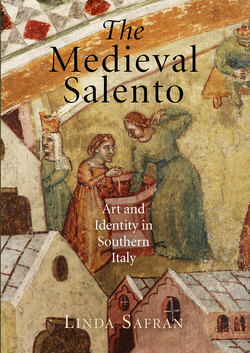The Medieval Salento

Реклама. ООО «ЛитРес», ИНН: 7719571260.
Оглавление
Linda Safran. The Medieval Salento
Отрывок из книги
The Medieval Salento
Ruth Mazo Karras, Series Editor
.....
Let us conclude with the late fourteenth-century apse inscription from Santi Stefani in Vaste [157.A]. The personal names recorded there—Antony, Doulitzia, Maria, and Ioanna (Jeanne)—reveal both continuity in onomastic fashion (Maria) and novelty (Antony, Ioanna). Long after the end of Byzantine domination, only one name in this Greek inscription is unambiguously Greek (Doulitzia). No surname is indicated despite the late date, which suggests the family’s nonelite social status. The fact that names of all members of the family are included makes this text unique among medieval Salentine visual sources. The toponym Nuci (Nociglia) and the location of the church speak to the agricultural roots of many local place names and the ancient Messapian origins of a few. The supplication situates the apse figures in a family and community context at a specific moment in time, the Byzantine year 6888. It underscores that names and kinship are among the core elements of medieval identity, which involved both persons and places. What, then, should we make of Kalia, Margaret, Stephen, and Donna, who are identified by name but not by kinship [157.C, I, K, M; Plate 18]? Perhaps they are related to George, son of Lawrence [157.G], and to Antony and his family in the apse [157.A], and this is a single-family cult site. The single women may all be independent widows, although this seems unlikely. In subsequent chapters I shall have more to say about these figures’ appearance, their status, and their painted expressions of piety.
Perhaps the most important aspect of names was the belief, shared by Jews and Christians alike, that names held power. Receiving an individual name at baptism afforded protection, and only named, baptized children could hope to enter heaven.142 Names could affect one’s future, and changing a name might fool demons or the angel of death, who summoned a person by name.143 Orthodox individuals entering a new life in a monastery or convent often received a new name. Foremost among the powerful names were the divine ones, only some of which were accessible to regular Christians and Jews.
.....